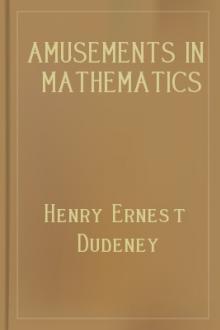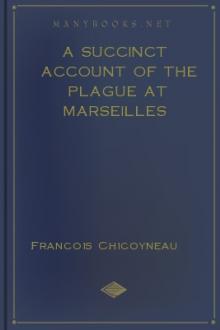Amusements in Mathematics, Henry Ernest Dudeney [books to read to be successful txt] 📗

- Author: Henry Ernest Dudeney
- Performer: 0486204731
Book online «Amusements in Mathematics, Henry Ernest Dudeney [books to read to be successful txt] 📗». Author Henry Ernest Dudeney
91.—MORE MIXED FRACTIONS.—solution
The point of the present puzzle lies in the fact that the numbers 15 and 18 are not capable of solution. There is no way of determining this without trial. Here are answers for the ten possible numbers:—
I have only found the one arrangement for each of the numbers 16, 20, and 27; but the other numbers are all capable of being solved in more than one way. As for 15 and 18, though these may be easily solved as a simple fraction, yet a "mixed fraction" assumes the presence of a whole number; and though my own idea for dodging the conditions is the following, where the fraction is both complex and mixed, it will be fairer to keep exactly to the form indicated:—
I have proved the possibility of solution for all numbers up to 100, except 1, 2, 3, 4, 15, and 18. The first three are easily shown to be impossible. I have also noticed that numbers whose digital root is 8—such as 26, 35, 44, 53, etc.—seem to lend themselves to the greatest number of answers. For the number 26 alone I have recorded no fewer than twenty-five different arrangements, and I have no doubt that there are many more.
92.—DIGITAL SQUARE NUMBERS.—solution
So far as I know, there are no published tables of square numbers that go sufficiently high to be available for the purposes of this puzzle. The lowest square number containing all the nine digits once, and once only, is 139,854,276, the square of 11,826. The highest square number under the same conditions is, 923,187,456, the square of 30,384.
93—THE MYSTIC ELEVEN.—solution
Most people know that if the sum of the digits in the odd places of any number is the same as the sum of the digits in the even places, then the number is divisible by 11 without remainder. Thus in 896743012 the odd digits, 20468, add up 20, and the even digits, 1379, also add up 20. Therefore the number may be divided by 11. But few seem to know that if the difference between the sum of the odd and the even digits is 11, or a multiple of 11, the rule equally applies. This law enables us to find, with a very little trial, that the smallest number containing nine of the ten digits (calling nought a digit) that is divisible by 11 is 102,347,586, and the highest number possible, 987,652,413.
94.—THE DIGITAL CENTURY.—solution
There is a very large number of different ways in which arithmetical signs may be placed between the nine digits, arranged in numerical order, so as to give an expression equal to 100. In fact, unless the reader investigated the matter very closely, he might not suspect that so many ways are possible. It was for this reason that I added the condition that not only must the fewest possible signs be used, but also the fewest possible strokes. In this way we limit the problem to a single solution, and arrive at the simplest and therefore (in this case) the best result.
Just as in the case of magic squares there are methods by which we may write down with the greatest ease a large number of solutions, but not all the solutions, so there are several ways in which we may quickly arrive at dozens of arrangements of the "Digital Century," without finding all the possible arrangements. There is, in fact, very little principle in the thing, and there is no certain way of demonstrating that we have got the best possible solution. All I can say is that the arrangement I shall give as the best is the best I have up to the present succeeded in discovering. I will give the reader a few interesting specimens, the first being the solution usually published, and the last the best solution that I know.
It will be noticed that in the above I have counted the bracket as one sign and two strokes. The last solution is singularly simple, and I do not think it will ever be beaten.
95.—THE FOUR SEVENS.—solution
The way to write four sevens with simple arithmetical signs so that they represent 100 is as follows:—
Of course the fraction, 7 over decimal 7, equals 7 divided by 7/10, which is the same as 70 divided by 7, or 10. Then 10 multiplied by 10 is 100, and there you are! It will be seen that this solution applies equally to any number whatever that you may substitute for 7.
96.—THE DICE NUMBERS.—solution
The sum of all the numbers that can be formed with any given set of four different figures is always 6,666 multiplied by the sum of the four figures. Thus, 1, 2, 3, 4 add up 10, and ten times 6,666 is 66,660. Now, there are thirty-five different ways of selecting four figures from the seven on the dice—remembering the 6 and 9 trick. The figures of all these thirty-five groups add up to 600. Therefore 6,666 multiplied by 600 gives us 3,999,600 as the correct answer.
Let us discard the dice and deal with the problem generally, using the nine digits, but excluding nought. Now, if you were given simply the sum of the digits—that is, if the condition were that you could use any four figures so long as they summed to a given amount—then we have to remember that several combinations of four digits will, in many cases, make the same sum.
Here the top row of numbers gives all the possible sums of four different figures, and the bottom row the number of different ways in which each sum may be made. For example 13 may be made in three ways: 1237, 1246, and 1345. It will be found that the numbers in the bottom row add up to 126, which is the number of combinations of nine figures taken four at a time. From this table we may at once calculate the answer to such a question as this: What is the sum of all the numbers composed of our different digits (nought excluded) that add up to 14? Multiply 14 by the number beneath t in the table, 5, and multiply the result by 6,666, and you will have the answer. It follows that, to know the sum of all the numbers composed of four different digits, if you multiply all the pairs in the two rows and then add the results together, you will get 2,520, which, multiplied by 6,666, gives the answer 16,798,320.
The following general solution for any number of digits will doubtless interest readers. Let n represent number of digits, then 5 (10n - 1) ) 8! divided by (9 - n)! equals the required sum. Note that 0! equals 1. This may be reduced to the following practical rule: Multiply together 4 × 7 × 6 × 5 ... to (n - 1) factors; now add (n + 1) ciphers to the right, and from this result subtract the same set of figures with a single cipher to the right. Thus for n = 4 (as in the case last mentioned), 4 × 7 × 6 = 168. Therefore 16,800,000 less 1,680 gives us 16,798,320 in another way.
97.—THE SPOT ON THE TABLE.—solution
The ordinary schoolboy would correctly treat this as a quadratic equation. Here is the actual arithmetic. Double the product of the two distances from the walls. This gives us 144, which is the square of 12. The sum of the two distances is 17. If we add these two numbers, 12 and 17, together, and also subtract one from the other, we get the two answers that 29 or 5 was the radius, or half-diameter, of the table. Consequently, the full diameter was 58 in. or 10 in. But a table of the latter dimensions would be absurd, and not at all in accordance with the illustration. Therefore the table must have been 58 in. in diameter. In this case the spot was on the edge nearest to the corner of the room—to which the boy was pointing. If the other answer were admissible, the spot would be on the edge farthest from the corner of the room.
98.—ACADEMIC COURTESIES.—solution
There must have been ten boys and twenty girls. The number of bows girl to girl was therefore 380, of boy to boy 90, of girl with boy 400, and of boys and girls to teacher 30, making together 900, as stated. It will be remembered that it was not said that the teacher himself returned the bows of any child.
99.—THE THIRTY-THREE PEARLS.—solution
The value of the large central pearl must have been £3,000. The pearl at one end (from which they increased in value by £100) was £1,400; the pearl at the other end, £600.
100.—THE LABOURER'S PUZZLE.—solution
The man said, "I am going twice as deep," not "as deep again." That is to say, he was still going twice as deep as he had gone already, so that when finished the hole would be three times its present depth. Then the answer is that at present the hole is 3 ft. 6 in. deep and the man 2 ft. 4 in. above ground. When completed the hole will be 10 ft. 6 in. deep, and therefore the man will then be 4 ft. 8 in. below the surface, or twice the distance that he is now above ground.
101.—THE TRUSSES OF HAY.—solution
Add together the ten weights and divide by 4, and we get 289 lbs. as the weight of the five trusses together. If we call the five trusses in the order of weight A, B, C, D, and E, the lightest being A and the heaviest E, then the lightest, no lbs., must be the weight of A and B; and the next lightest, 112 lbs., must be the weight of A and C. Then the two heaviest, D and E, must weigh 121 lbs., and C and E must weigh 120 lbs. We thus know that A, B, D, and E weigh together 231 lbs., which, deducted from 289 lbs. (the weight of the five trusses), gives us the weight of C as 58 lbs. Now, by mere subtraction, we find the weight of each of the five trusses—54 lbs., 56 lbs., 58 lbs., 59 lbs., and 62 lbs. respectively.
102.—MR. GUBBINS IN A FOG.—solution
The candles must have burnt for three hours and three-quarters. One candle had one-sixteenth of its total length left and the other four-sixteenths.
103.—PAINTING THE LAMP-POSTS.—solution
Pat must have painted six more posts than Tim, no matter how many lamp-posts there were. For example, suppose twelve on each side; then Pat painted fifteen and Tim nine. If a hundred on each side, Pat painted one hundred and three, and Tim only ninety-seven





Comments (0)